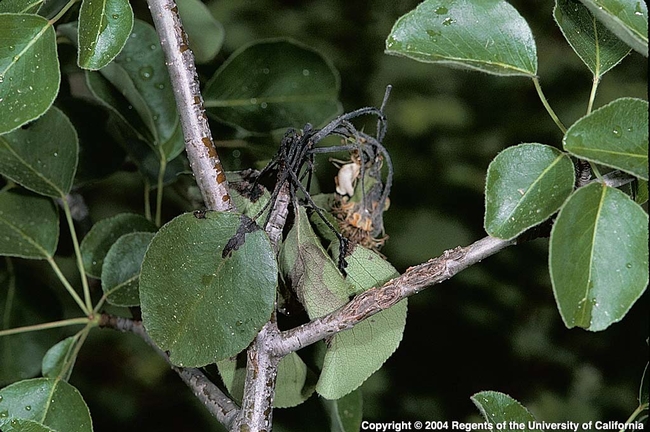By the UC Master Gardener Program of Fresno County
- Prepared by: Terry Lewis
Published on: July 19, 2024
Forget the guilt about what's going on outside. It's not your fault that it's hot! Fire blight caused this pear blossom and terminal to suddenly wilt, blacken and die. Prune out infected growth. (Photo: UC IPM)
Fire blight caused this pear blossom and terminal to suddenly wilt, blacken and die. Prune out infected growth. (Photo: UC IPM)
Tasks
- Check sprinklers and adjust timers weekly if necessary.
- Pre-irrigate to soften the ground for tilling in preparation for fall gardens.
- When the lawn needs mowing, mow cool-season grasses, such as tall fescue, to 3 inches and bermudagrass to 1 inch. Mowing shorter than these levels will encourage weeds and a shallow, less-drought-tolerant root structure.
Pruning
- Prune apricot, oleander and olive trees during dry weather to reduce future disease problems.
Fertilizing
- Cut back on fertilizer when water is limited and landscape plants remain in drought survival mode.
Planting
- Avoid planting annuals and perennials unless it is absolutely necessary.
- Bulbs, corms, tubers: autumn crocus.
- A few winter vegetables may be planted from seed. Consult the California Garden Web for more information.
Enjoy now
- Annuals and perennials: fibrous begonia (Begonia semperflorens), vinca (Catharanthus), cockscomb (Celosia), morning glory (Convolvulus tricolor).
- Bulbs, corms, tubers: dahlia.
- Trees, shrubs, vines: trumpet vine (Campsis), hydrangea, morning glory (Ipomoea).
- Fruits and vegetables: eggplant, fig, garlic, grapes, onion.
Things to ponder
- Fire blight infections are best pruned out in winter when the disease is not active. However, if the infection is spreading rapidly, prune out the infected growth as soon as it appears.
- Drought tip: Preserve the largest climate appropriate plants in the landscape. Mature trees and large shrubs may take many years or even decades to replace, while groundcovers, lawns, flower beds and vegetable gardens can be re-established in a season or two.
Tags: This week (0)
Comments: 0
No Comments Posted.
Leave a Reply:

